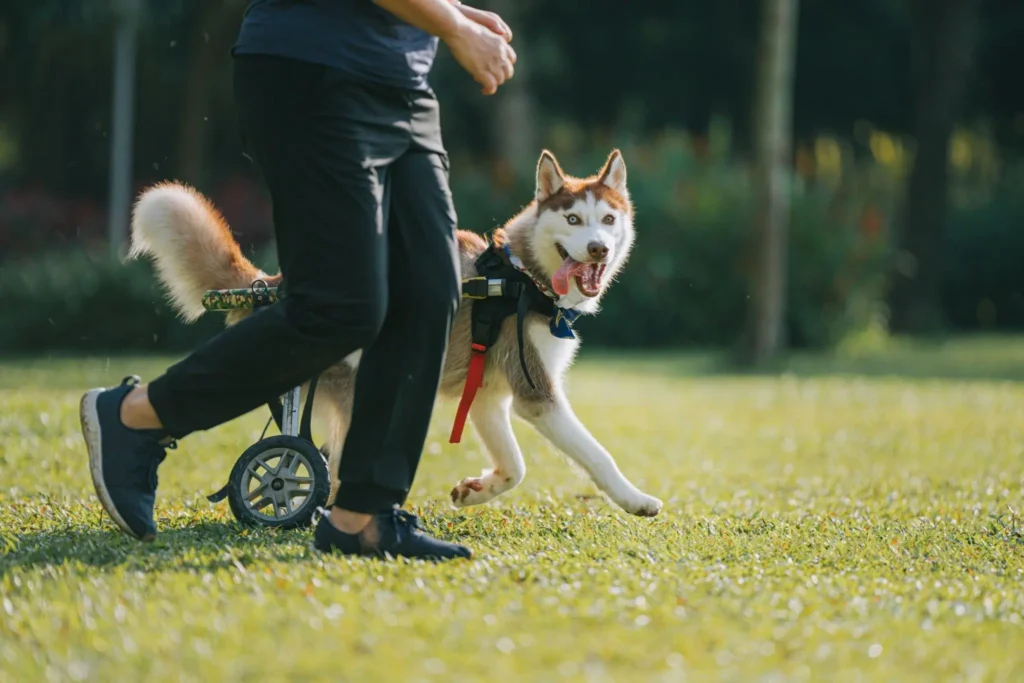Rehabilitation training for dogs has become essential to veterinary care because it helps dogs get better after being hurt, having surgery, or having a disease that worsens over time.
With the right rehabilitation program, dogs can regain mobility, deal with pain, and improve their general quality of life.
In this article, we’ll talk about how dog rehabilitation training can help our furry friends.

Understanding Rehabilitation Training for Dogs
Rehabilitation training for dogs is a set of therapeutic tasks and techniques to help them get better and get back to normal.
It is often used to treat orthopedic injuries, help people get better after surgery, and treat illnesses that worsen over time. This specialized training is crucial to giving a dog back its strength, flexibility, and ability to work.
Common Conditions Requiring Rehabilitation Training
Orthopedic Injuries:
- Fractures, sprains, and strains
- Cruciate ligament tears
- Hip dysplasia
Post-surgery Recovery:
- Orthopedic surgeries (e.g., joint replacements)
- Spinal surgeries
- Soft tissue surgeries (e.g., torn ligaments)
Degenerative Diseases:
- Osteoarthritis
- Intervertebral disc disease
- Degenerative myelopathy
Benefits of Rehabilitation Training for Dogs
Rehabilitation training has many benefits for dogs who are getting better or who have trouble moving around. Some of the main perks are:
Improved Mobility and Strength:
Therapeutic exercises and targeted training help dogs regain muscle strength and joint flexibility, enabling them to move more comfortably.
Pain Management:
Rehabilitation techniques, such as massage and hydrotherapy, can alleviate pain and discomfort associated with various conditions, promoting a better quality of life.
Enhanced Quality of Life:
By improving overall physical function and reducing pain, rehabilitation training helps dogs engage in daily activities, enjoy exercise, and maintain a happy and fulfilling life.
Components of Rehabilitation Training
Therapeutic Exercises:
- Range of motion exercises
- Strengthening exercises
- Proprioception exercises
Hydrotherapy:
- Underwater treadmill
- Swimming exercises
Massage and Stretching:
- Gentle massage techniques
- Passive and active stretching exercises
Balance and Coordination Training:
- Balance boards
- Balance discs
- Cavaletti poles
Finding a Qualified Rehabilitation Professional
When seeking rehabilitation training for your dog, finding a qualified professional specializing in veterinary rehabilitation is essential. Look for the following:
Veterinary Rehabilitation Specialists:
Veterinarians with additional training and certification in rehabilitation
Collaborative approach with your primary veterinarian
Certifications to Look For:
Certified Canine Rehabilitation Practitioner (CCRP)
Certified Canine Rehabilitation Therapist (CCRT)
Rehabilitation Training Process
The rehabilitation training process typically involves the following steps:
Evaluation and Assessment:
- Comprehensive physical examination
- Assessment of gait, mobility, and pain levels
Individualized Treatment Plans:
- Tailored exercises and techniques based on the dog’s specific condition and needs
- Gradual progression of activities as the dog improves
Progress Tracking and Adjustments:
- Regular re-evaluations to monitor progress
- Adjustments to the treatment plan as necessary
Precautions and Considerations
When performing rehabilitative training on your dog, keep the following precautions and factors in mind:
Age and Health Factors:
The training program should be tailored to the dog’s age, overall health, and current medical issues.
Gradual Progression of Exercises:
To avoid overexertion or worsening the problem, begin with easy workouts and gradually increase the difficulty.
Regular Communication with the Veterinarian:
Keep your primary veterinarian up to date on the rehabilitation training process and talk with them if any concerns emerge.
Conclusion
Rehabilitation training is critical in recovering and improving dogs suffering from orthopedic injuries, post-surgery healing, and degenerative diseases. Dogs can regain movement, manage discomfort, and have a higher quality of life by following a personalized program designed by a skilled specialist.
Consult with a veterinary rehabilitation professional if your pet requires rehabilitation training to ensure they receive the finest care possible.
FAQs
Can rehabilitation training completely cure my dog’s condition?
While rehabilitation training can significantly improve a dog’s condition, it may not guarantee a cure. However, it can substantially enhance their quality of life.
How long does rehabilitation training typically take?
The duration of rehabilitation training varies depending on the dog’s condition, response to treatment, and other factors. It can range from a few weeks to several months.
Are there any risks involved in rehabilitation training?
When conducted under the guidance of a qualified professional, rehabilitation training is generally safe. However, it is essential to follow the instructions carefully to prevent any potential risks or complications.
Can I perform rehabilitation exercises at home?
Some exercises and techniques can be performed at home. Still, receiving proper guidance from a rehabilitation professional is crucial to ensure they are done correctly and safely.
Is rehabilitation training only for dogs recovering from injuries?
No, rehabilitation training can benefit dogs with many conditions, including chronic diseases like arthritis or degenerative disorders like hip dysplasia.



